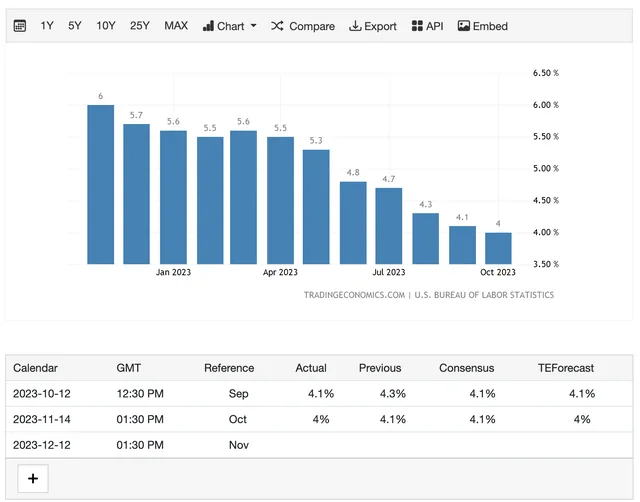
The economic landscape of the United States is under the scrutiny of economists and financial analysts as the annual inflation rate has recently been reported at 3.2%, slightly below the expected 3.3%. This revelation sparks a cascade of questions and discussions, unraveling the intricate dynamics of inflation and its far-reaching implications. In this comprehensive exploration, we delve into the factors influencing this rate, its impact on various sectors, and what it means for the average American.
Understanding the Numbers: Breaking Down 3.2%
The annual inflation rate is a crucial economic indicator, measuring the percentage increase in the average price level of goods and services over a specific period. In the United States, the recent report of 3.2% has caught the attention of both experts and the general public. But what does this number truly signify?
Factors Contributing to the 3.2% Inflation Rate
Several factors contribute to the reported inflation rate. The increase in demand for goods and services, supply chain disruptions, and rising production costs are among the key drivers. Understanding the interplay of these elements provides a nuanced perspective on the dynamics behind the numbers.
- Demand-Supply Dynamics: The surge in consumer demand, fueled by factors like pent-up demand post-pandemic and increased consumer spending, has put pressure on the supply chain. As demand outstrips supply, prices naturally rise, contributing to the inflation rate.
- Supply Chain Disruptions: The global supply chain has faced unprecedented challenges in recent times, from shipping delays to shortages in crucial raw materials. These disruptions have a domino effect on prices, impacting various industries and pushing the inflation rate upward.
- Rising Production Costs: Increased costs of production, including labor, energy, and materials, play a significant role in inflation. Businesses often pass these costs onto consumers through higher prices, adding to the overall inflationary pressure.
The Ripple Effect: Sectors Affected by Inflation
The annual inflation rate of 3.2% reverberates across different sectors, influencing everything from daily expenses to major investments. Let’s explore how this inflationary environment affects various aspects of the economy.
Consumer Impact: Navigating Higher Prices
For the average American, the 3.2% inflation rate translates to higher prices for everyday goods and services. From groceries to gas prices, consumers may find their budgets stretched as the cost of living inches upward. This prompts a reconsideration of spending habits and financial planning.
Real Estate and Investments: Mixed Fortunes
The real estate market and investments experience a mixed bag of outcomes in an inflationary environment. While property values may rise, offering potential gains for homeowners, interest rates could also increase, impacting mortgage affordability. Investors must carefully navigate these waters to capitalize on opportunities and mitigate risks.
Business Landscape: Strategies for Adapting
Businesses face the challenge of balancing increased operational costs with maintaining competitiveness. Some may pass the burden onto consumers, while others explore innovative strategies to optimize efficiency. Adapting to the inflationary landscape becomes crucial for sustained growth.
Government Responses: Policies and Interventions
In response to the reported annual inflation rate of 3.2%, policymakers are tasked with crafting effective strategies to manage economic stability. The Federal Reserve plays a pivotal role in implementing monetary policies that aim to curb inflation without stifling economic growth.
Monetary Policy Adjustments: Navigating Economic Waters
The Federal Reserve employs various tools, such as adjusting interest rates and open market operations, to influence the money supply and control inflation. Striking the right balance is a delicate task, requiring a nuanced understanding of economic indicators and trends.
Fiscal Measures: Government Spending and Inflation
Government spending also plays a role in shaping the inflationary landscape. Increased public expenditure can stimulate economic activity but may also contribute to inflation. Policymakers must weigh the benefits of economic stimulus against the potential downsides of rising inflation.
Future Projections: What Lies Ahead?
As the United States grapples with a reported annual inflation rate of 3.2%, the question on everyone’s minds is, what lies ahead? Economic forecasts and expert analyses offer insights into potential scenarios and the resilience of the economy in the face of inflationary pressures.
Economic Forecasts: Navigating Uncertainty
Economists engage in rigorous analyses to project future inflation rates based on current trends. These forecasts guide businesses, investors, and policymakers in making informed decisions amidst economic uncertainty.
Resilience and Adaptation: A Call to Action
In conclusion, the reported annual inflation rate of 3.2%, slightly below the expected 3.3%, prompts a collective call to action. Individuals, businesses, and policymakers must navigate these economic waters with resilience and adaptability. Understanding the intricacies of inflation, its drivers, and the ripple effects across sectors is paramount in making informed decisions for a sustainable economic future.
The annual inflation rate in the United States has been reported at 3.2%, slightly below the expected 3.3%. This numerical revelation serves as a compass, guiding the nation through the complexities of economic dynamics. As the journey unfolds, only time will reveal the true impact and resilience of the U.S. economy in the face of inflationary challenges.